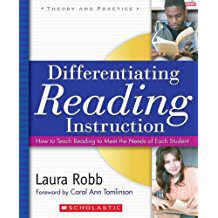Is there a perfect or best way for students to select an independent reading book? I don’t think so. Since I’ve been teaching, the five-finger method is a strategy that teachers pass on to students. This technique asks a student to read 100 words and if there are five the student can’t say and/or understand, they look for a different book. I am not a fan of the five-finger method. Having difficulty with five words per one hundred words can be problematic for students with fluency issues. For me, there’s no one method of selecting a book that students use. It’s all about relationships that enable you to offer guidance that resonates with each child and meets that child’s needs.
I wish I could offer you one or two methods that always work. I can’t. My teaching head believes that for students to enjoy an independent reading book, it should be close to 100% accuracy. However, my students have taught me that exceptions to this belief abound! Take Marta, a third grade student who was instructionally on grade level. She checked out The Wizard of Oz on a visit to the library. Definitely, far above her instructional level, so I asked Marta, “Tell me why you want to read it.”
“I’ve seen the movie three times. I really want to read the book.”
“You certainly have a lot of background knowledge, “ I said. “Try it. Know that you might have to reread parts.” A happy Marta skipped to the computer to check out her book. Marta read The Wizard of Oz three times. “The second to get it [the story] better. The third ‘cause I could really read it.” Marta shows us that choosing books is more complicated than we thought. Here are five suggestions to guide you.
- Have students share what they want to read with you. Go to library period with your students and be there to suggest books, to hear why they “must” read a book. Invite students to run by you books they select from your classroom library.
- Offer alternatives. Avoid taking a book away from a student. Instead, suggest two alternatives just in case they want to switch. Abandoning a book should be a student’s choice.
- Listen to students’ reasons. Always ask “why” and listen. What the student says can support your suggestions. If you’re unsure, let the student try the book and explain that it’s okay to abandon it.
- Adopt book talking. Each month, invite students to book talk a favorite independent reading book. Spread these over two days. Just imagine, a class of twenty-five students will hear 250 book talks in ten months. They’ll discover many books that interest them—books they choose to read based on peer recommendation.
- Approve of abandoning a book. When I was in school, I had to finish a book, even if I disliked it. The idea was that I’d learn the discipline of completing what I had started. That doesn’t work. It creates anger and intense dislike—two emotions you don’t want student to associate with reading. When a student abandons a book, I like them to tell me why, only because I’m interested in what causes this decision.
Closing
Your advanced and proficient readers have learned, through experience, how to select a book to enjoy. However, English language learners and students reading below grade level benefit from your support. So say “good-bye” to strategies that don’t work for them, including the five-finger method. Instead, take the time to deepen your relationships with students by supporting their independent reading choices! With practice, they’ll figure out how to choose, but also know it’s okay if they recognize the book is not for them YET and find another. One day, if the student still wants to read it, he or she will.
Learn more about Laura’s ideas on reading- check out- Teaching Reading in Middle School
![]()














